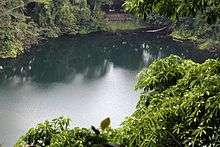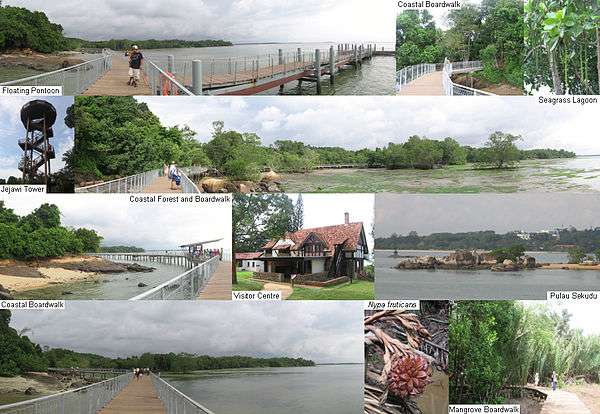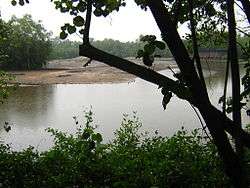Biosphere reserves in Singapore
The Singaporean government has established five biosphere reserves in Singapore. There are Bukit Timah Nature Reserve, Central Catchment Nature Reserve, Chek Jawa, Labrador Nature Reserve, and Sungei Buloh Wetland Reserve.

History
One of the first notions of biosphere reserves in Singapore was thought up by the then-Singapore Botanical Gardens Supritendent N. C. Cantley who, in 1882, proposed that select areas of land be preserved. In as early as 1883, the Bukit Timah Nature Reserve (as it is now known) was established, making it the inaugural biosphere reserve in Singapore.[1] The Singapore Nature Reserves Act officially came into action in 1971. In 1984, biosphere reserves took up some 2,000 hectares (4,900 acres) of the country's land.[1] This figure has been increased to 3,000 hectares (7,400 acres), as of 2009.[2]
Biosphere reserves
The Public Utilities Board-maintained Central Catchment Nature Reserve is Singapore's largest biosphere reserve.[1] The Sungei Buloh Wetland Reserve aids in the conservation of both bird species and mangrove plants.[2] The Bukit Timah Nature Reserve, albeit small-sized at 164 hectares (410 acres), hosts myriad plant and animal lifeforms.[3] Chek Jawa is situated in eastern Pulau Ubin. Teeming with various kinds of marine life, Chek Jawa was "discovered" (much publicised) in 2001.[4] The Labrador Nature Reserve is located by the sea. Described as "an oasis of tranquility and natural wonders", it teems with vast animal life, as well as plant life by the cliff.[5] The 131 hectares (320 acres) large Sungei Buloh Wetland Reserve comprises mostly wetland and a few bird species, most notably the shorebird, can be spotted there.[6] It is cited as the "first wetlands reserve to be gazetted in Singapore".[7]
Issues
Owing to rapid urban development, the country is in need of more land for things such as housing, which is deemed more important than nature reservation. One possible issue faced by the biosphere reserves in Singapore is that they will be turned into nothingness by the government when the need arises.[3] There was an instance when the government had wanted to reclaim part of Chek Jawa, but this was opposed by conservationists and it was ultimately not reclaimed.[8]
Gallery

 A montage of Chek Jawa, showcasing its features
A montage of Chek Jawa, showcasing its features- Signage of Sungei Buloh Wetland Reserve
 The wetlands of Sungei Buloh Wetland Reserve
The wetlands of Sungei Buloh Wetland Reserve- Labrador Nature Reserve during low tide
See also
- Protected areas of Singapore
References
- Hsuan Keng (1990). The Concise Flora of Singapore: Gymnosperms and Dicotyledons. 1. NUS Press. pp. 20–. ISBN 9789971691356.
- Tan, Karean (2009). Clean, Green and Blue: Singapore's Journey Towards Environmental and Water Sustainability. Institute of Southeast Asian Studies. pp. 75–. ISBN 9789812308610.
- Tribe, John (2000). Fortest tourism and recreation: case studies in environmental management. CABI. pp. 10–. ISBN 9781845933036.
- Social Studies Sec 2 Nt Tb. Pearson Education South Asia. 2006. pp. 92–93. ISBN 9789812476913.
- "Labrador Nature Reserve". National Parks Board. Archived from the original on May 2, 2014. Retrieved June 4, 2013.
- Stroud, David A. (2006). Waterbirds Around the World: A Global Overview of the Conservation, Management and Research of the World's Waterbird Flyways. The Stationery Office. pp. 343–. ISBN 9780114973339.
- MobileReference (2007). Travel Singapore: Illustrated Travel Guide, Phrasebook, and Maps. MobileReference. pp. 239–. ISBN 9781605010151.
- Alagappa, Muthiah (2004). Civil Society And Political Change In Asia: Expanding And Contracting Democratic Space. Stanford University Press. pp. 341–. ISBN 9780804750974.